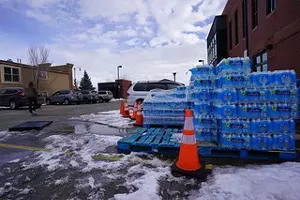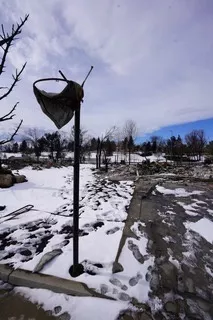Near the epicenter, however, those impacted are far less focused on the cause than the effect.
In Boulder, your rings of separation from those impacted disappear. It seems everyone has a friend, coworker or family member who lost a home. As a teacher, empty chairs in my classroom represent students who still have no home to return to. If you lived near the epicenter but your house remained standing, the subsequent winter storm froze your pipes because of the lack of electricity. The impact is unprecedented in Colorado history.
There are murmurs highlighting how lucky these residents are. Many of the homes burned were valued near one million dollars, and there are assumptions being made that everyone impacted will be fine because of their financial well-being. After walking the streets of a neighborhood leveled by the fire, I’m sure residents feel anything but lucky. After all, how many items lost were irreplaceable? A “Happy Father’s Day” coffee mug your son made you when he was six, the fruit tree out back that had been pruned and nurtured for years, the seven-year-old Labrador retriever that had a personality of her own. No amount of insurance money will ease the pain of these losses.
Stopping for coffee this morning, the parking lot to the Louisville Public Library was bustling. Dozens of families lugged boxes from their cars to the library, left, and then another family filled the same parking space. As I walked inside, dozens more families were placing toys, books, furniture, cases of water, kitchen supplies and many other donations on tables in a makeshift community room. I recognized an old colleague of mine with her two young children setting a Barbie playhouse on a table labeled “Dolls.” We hugged and I asked how she was holding up. Tears pooled in her eyes as she looked down at her kids and with a chipper tone said, “The kids said they wanted to give their Christmas presents to the boys and girls that lost their homes and presents in the fire.”
A number of volunteers arranged a supply donation center for families that lost everything in the fires. Although there were dozens of people around, the room was relatively silent. There were hugs and tearful hellos, but the atmosphere was dutiful rather than cheerful. The community asked no questions and droves of locals came together to help those in need. The emotions were heavy here. If the pandemic wasn’t the uniting disaster we thought it would be, for Boulder County, this was the disaster that united us.
Strangers helped strangers lift boxes of donations, kids dropped off bags of LEGO sets, and busy volunteers guided the river of donations to their correct destinations. Family friends had thought the fire was unlikely to reach their home; they evacuated, just grabbing important papers and hard drives. Two days after the fire, they received confirmation that their house had been burned to the ground. The loss of family heirlooms, freshly opened Christmas presents and the comforts of home have untethered their lives.
The donations and outpouring help from citizens is a sight to behold. Few events lately have been able to restore our faith in humanity. Seeing the community come together during this catastrophe is awe-inspiring. One volunteer at the library has a name tag on her sweater that reads “Kathy.” I ask if she is in charge. She shakes her head and says, “The woman with the white vest is in charge. I don’t know her name, but she has been the ringleader of everything so far.”
I go up to the woman in the white vest and ask if it is all right if I take a few pictures to capture the emotion of the event. She nods and says I need to finish up my shots before the impacted families arrive; she wants to make sure they have privacy during these trying times. This white-vested stranger that no one knows will work all weekend to coordinate the influx of donations. My faith in humanity has been restored.
After walking through a decimated neighborhood, President Joe Biden revealed that the impact is “as devastating as it looks.” As I entered another leveled neighborhood, the smell was unexpected. These fires don’t smell like campfires and marshmallows. Fireworks, gunpowder and burnt plastic seem like more fitting descriptors. Torched cars, bricks and metal yard decorations are all that’s left of the thousands of structures destroyed by the Marshall fire.
Teary-eyed families sift through the ashes with shovels, hoping to find sentimental items spared by the flames. A storage bin full of pictures from the ’90s, your computer with all your family photos, an urn that was on the mantel. All that’s left is the basketball hoop at the end of the cul-de-sac, the plastic backboard melted to the pavement. The burned frame of a trampoline in the backyard. Without fences, trees and houses to block the view, miles of rubble and ashes are revealed. A scorched metal wind spinner spins in the breeze in front of an ash pile that once was a four-bedroom home. A number of houses still have a chimney or brick facade standing, which is where firefighters spray-painted an orange number revealing the address of the destroyed home. Without these numbers, it might be difficult for homeowners to find the remains of their home.
Most houses don’t have anything vertical left, so firefighters spray-paint the house number right on the driveway, in one case next to the charred skeleton of a Jeep Wrangler. You could speculate that new houses, sod and trees will begin arriving any year now. As of right now, though, the ghosts of the past are the only things you can focus on as you walk on this burnt land.
The Marshall fire isn’t relevant on the national news anymore, but for Boulder County, it is still in the forefront of our minds. The emotional roller coaster of despair and communal help is powerful and humbling. This is certainly our unifying disaster.
Dustin Bailey grew up in the mountains of Colorado. In addition to teaching, he has cooked professionally, worked with biodynamic farms and in plant genetics labs; he recently founded Farm to Bus, a rolling farmer’s market. See more of his work here.
Westword frequently publishes opinion pieces and essays on the weekends on westword.com. Have one you’d like to submit? Send it to [email protected], where you can also comment on this piece.
Stay connected with us on social media platform for instant update click here to join our Twitter, & Facebook
We are now on Telegram. Click here to join our channel (@TechiUpdate) and stay updated with the latest Technology headlines.
For all the latest For Top Stories News Click Here




